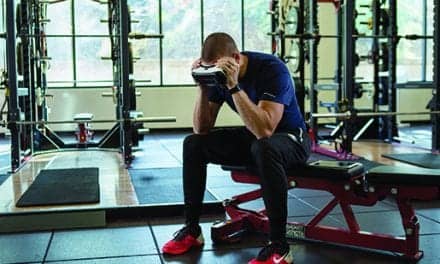by Gaston Pleiman, PT, DPT, CEAS
All physical therapists know that an improper warm up can put an athlete’s body at serious risk. Pulled muscles, torn ligaments, and strains and sprains can often be traced back to the way the athlete prepared for that day’s practice or game. These issues carry over when rehabbing injuries to get athletes back to 100%. However, many times the strategy behind proper stretching, warm-ups, and recovery methods is carried out poorly using old methods. This article outlines approaches for guiding proper stretches as a way to prevent injuries as well as help athletes recovery from injuries, should they occur.
The Problem with Warming Up
A standard issue with pre-game and pre-practice warm-ups is that the movements do not prepare the individual for how he or she will move once the activity required to participate in the sport has begun. One approach that is often used by team leaders, such as coaches or team captains, is to prepare their teams for activity by jogging a warm-up lap and then sitting on the ground to stretch. But in analyzing this approach for a specific sport—for example, football—a question should be asked about how much time the players, themselves, will actually spend jogging or sitting down on the field? The answer, of course, is almost never, since on-field play is comprised primarily of quick bursts of sprinting and use of strength, with periods between plays laced with cool-downs.
In other words, even after warming up and stretching, these athletes are still not prepared for the strain that a game or a demanding practice will place on their bodies. In short: static stretching can still leave athletes highly vulnerable to injuries.
A Better Way to Warm Up
The motion of sitting down and stretching the hamstring muscle is never going to happen in a sporting event. Athletes often begin in a fixed position and use explosive movements to help their team. Practices, then, should be constructed so that during warm-ups, athletes mimic the actions that will be performed during the game.
The best warm-ups will have the athletes imitating the ways they will move when they play. Returning to the football example, perhaps, instead of jogging a warm-up lap, the players participate in a series of short sprints. These shorter distances will better mimic the on-and-off play that will take place during an actual game. The athletes can also stretch with light exercise-like lunges or other leg exercises that mimic the strain their legs will take—for example, as an offensive lineman would perform his blocking duties.
Dynamic stretches will also help to reduce the risk of injury. The difference between dynamic stretches and sitting stretches are that dynamic stretches involve motion. The motion is crucial in preparing the body for how it is supposed to move. Some great dynamic stretches to use are stepping lunges and high-knees. The main takeaway here is that the way an athlete prepares for a sporting event should imitate how they will move in any sport.
Sports Injury Rehabilitation: a Preparation Mind-set
No matter how well an athlete prepares, or the level at which he or she performs a given sport, the nature of sports is such that there is no way to fully protect an athlete from an injury. Variables such as landing strangely after jumping for a ball, or making contact with another athlete, are examples of unpredictable factors that can lead to injury. So what steps should be taken after a sports injury?
The first step is, of course, for the physical therapist to design a treatment plan. The injury that occurred is often the source of another problem, so the damage is a symptom and not the problem itself. It falls to the therapist to determine what the overall problem is: If the issue is a torn ACL, then the problem often lies somewhere in the hips, for example. Identifying the root of the problem will lead to treatment that will prevent future injuries.
The next step is for patients to complete their full course of therapy successfully, in compliance with what the therapist has mapped out. After rehabilitating the injury, the athlete must exercise great caution in returning to game play.
Similar to stretching and warm-ups, the athlete should begin by testing their ability to move as required. If he or she can move properly, then put them into practice for a week or two, so they can begin to put those movements into the proper context. Rehabbing an injury boils down to re-teaching and assessing the athlete’s ability to complete the movements they will perform on the field.
Allow Complete Recovery
Though coaches, parents, and athletes themselves may try to hasten a return to play, it is crucial that an athlete be allowed sufficient time to recover after injury. Gradually increasing the strain placed on the body as he or she moves allows the body to get back in shape. Putting a recovering athlete back into full contact practice or game situations can actually worsen the problem, because the athlete will need to adjust how he or she moves to compensate for the existing injury. Allowing the athlete to recover is vital to preventing further injuries. RM
Gaston Pleiman, PT, DPT, CEAS, completed his residency for advanced Orthopedic training through Evidence in Motion, a leading research institute for Physical Therapy practice. He is a practicing physical therapist at Physical Therapy Specialists of Columbus, Gahanna, Ohio, and utilizes the most current and supported interventions for his patients. Pleiman earned his Doctorate in Physical Therapy from the University of Dayton in 2013, and his Bachelor of Science from the University of Toledo in 2010. For more information, contact [email protected].
The (Therapy) Band Plays On
Evidence shows how flexibility and affordability help make the case for elastic therapy bands in treating sports injuries
by Frank Long, Editorial Director
After an injury, athletes may face the twin concerns of losing the edge on finely honed, sport-specific skills developed through months of training, and losing the strength and endurance to power those skills. The athlete, alone, bears the hard work of summoning the patience to wait out a recovery period. However, PTs can lend a hand in rebuilding strength and endurance levels, once the athlete is cleared for therapy. Recent research illustrates that there are simple, affordable, easy-to-perform approaches that can be used, especially in the case of lower extremity injuries, to return an athlete to sport.
High Stakes for Lower Extremities
Patellofemoral pain is an injury that is common and can be seen among various types of athletics.1 Current evidence suggests one approach that can be used to improve patient-reported function and decrease the amount of patellofemoral pain is hip strengthening alone or combined with quadriceps training.1 To accomplish this, therapists may find side-lying and standing hip abduction exercises that incorporate an elastic band or ankle weight useful.2,3,4 Evidence-backed research has also show that the lateral rotators of the hip can be strengthened using seated hip external rotation with or without an elastic band.2,3,4,5
A traumatic hip dislocation is an injury that most frequently is associated with automobile accidents rather than athletic endeavor.6 Nonetheless, this injury can and does occur in contact sports. When an athlete receives this type of injury, it most commonly is the result of a forward fall on the knee with a flexed hip.7 A recent case study spotlighted one such injury sustained by a high school football player while making a tackle. The player subsequently received a blow to the thigh from behind. Studies suggest that one way this type of injury occurs is a blow from behind when an athlete is positioned on all four limbs.8
Progressive Programming
Despite the seriousness of the injury, after surgical intervention, 6 weeks on crutches, and 5 months of physical therapy, the athlete returned to sport at the previous level of play.9 Therapeutic activity that included the use of elastic bands was an important part of the first month of rehabilitation. Among the comprehensive physical therapy regimen was progressive resisted exercise of the hip abductor, internal rotators, and external rotators.9 These activities were performed with and without elastic bands and, as the patient’s condition allowed, were progressed up to 5 pounds at 3 months, (10 repetitions × two sets).9 Non-weightbearing strengthening of the plantar flexors using progressive colored elastic bands was also used at 2 months (15 repetitions × two sets).9
Whether rehabbing athletes or non-athletes, elastic bands offer a tool for multipurpose physical training that is affordable, portable, and offer considerable ease of use. Likewise, they are available in systems that use various colors to differentiate the level of resistance the band is designed to provide. Research that used surface electromyography to compare the degree of muscle fatigue created by weight machines and elastic tubing points to another benefit associated with the use of elastic therapy bands, especially for applications where slow movement and minimal injury risk are essential.10 That research found that elastic bands, compared to pulley-based weight machines, required higher levels of muscle activation.10
The study authors also report that higher levels of “central” demand associated with eccentric contractions demanded by the continuous modification of the resistance (due to continuous variation in length of the elastic tube) appears to require a constant adaptation of the neuromuscular modulation of force in a finer way than what was observed with the use of weight machines.10 The authors also drew the conclusion that the utility of elastic bands for slow, low-risk therapeutic activity positioned it well as a postsurgery recovery tool.
Though sports injuries can range from superficial strains to traumatic collisions that require orthopedic surgery, the recovery process nearly always begins from a place of simplicity and safety. Therapeutic bands, balls, and tubing stand as one tool all therapists can look to in designing progressive rehabilitation programs that start small with the aim of achieving big goals. RM
References
1. Regelski CL, Ford BL, Hoch MC. Hip strengthening compared with quadriceps strengthening in conservative treatment of patients with patellofemoral pain: a critically appraised topic. International Journal of Athletic Therapy & Training. 2015;20(1):4–12.
2. Fukuda TY, Rossetto FM, Magalhaes E, Bryk FF, Lucareli PR, de Almeida Aparecida Carvalho N. Short-term effects of hip abductors and lateral rotators strengthening in females with patellofemoral pain syndrome: a randomized controlled clinical trial. J Orthop Sports Phys Ther. 2010;40(11):736–742.
3. Fukuda TY, Melo WP, Zaffalon BM, et al. Hip posterolateral muscu- lature strengthening in sedentary women with patellofemoral pain syndrome: a randomized controlled clinical trial with 1-year follow-up. J Orthop Sports Phys Ther. 2012;42(10):823–830.
4. Khayambashi K, Fallah A, Movahedi A, Bagwell J, Powers C. Postero- lateral hip muscle strengthening verses quadriceps strengthening for patellofemoral pain: A comparative control trial. Arch Phys Med Rehabil. 2014;95(5):900–907.
5. Dolak KL, Silkman C, Mckeon JM, Hosey RG, Lattermann C, Uhl TL. Hip strengthening prior to functional exercises reduces pain sooner than quadriceps strengthening in females with patellofemoral pain: a randomized clinical trial. J Orthop Sports Phys Ther. 2011;41(8):560–570.
6. Moorman CT, Warren RF, Hershman EB, et al. Traumatic posterior hip subluxation in American football. J Bone Joint Surg Am. 2003;85:1190-1196.
7. Epstein HC. Traumatic dislocations of the hip. Clin Orthop Relat Res. 1973;92: 116-142.
8. Giza E, Mithöfer K, Matthews H, Vrahas M. Hip fracture-dislocation in football: a report of two cases and review of the literature. Br J Sports Med. 2004;38:E17.
9. Yates, C, Bandy, WD, Blasier, RD. Traumatic Dislocation of the Hip in a High School Football Player. Physical Therapy. 2008;88(6):780-8.
10. Melchiorri G, Rainoldi A. Muscle fatigue induced by two different resistances: Elastic tubing versus weight machines. J Electromyogr Kinesiol. 2011;21:954-959.





